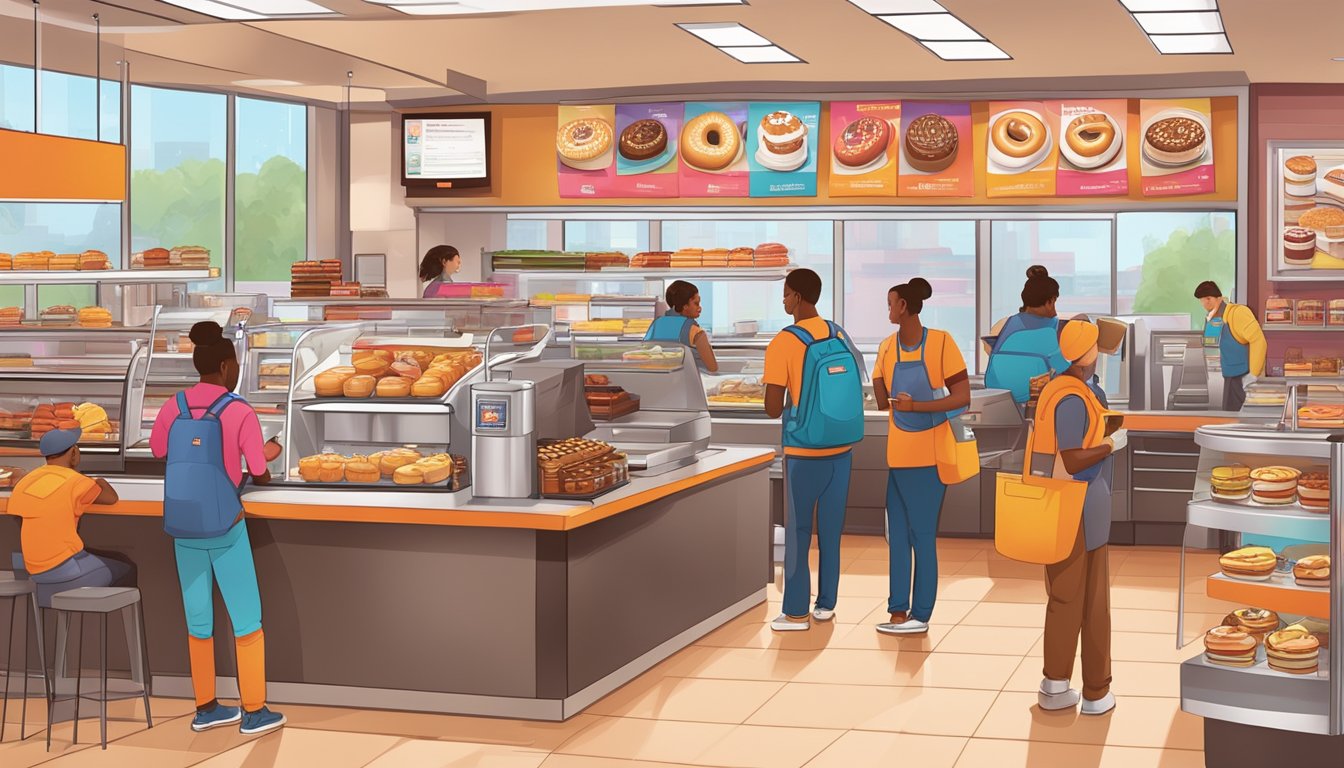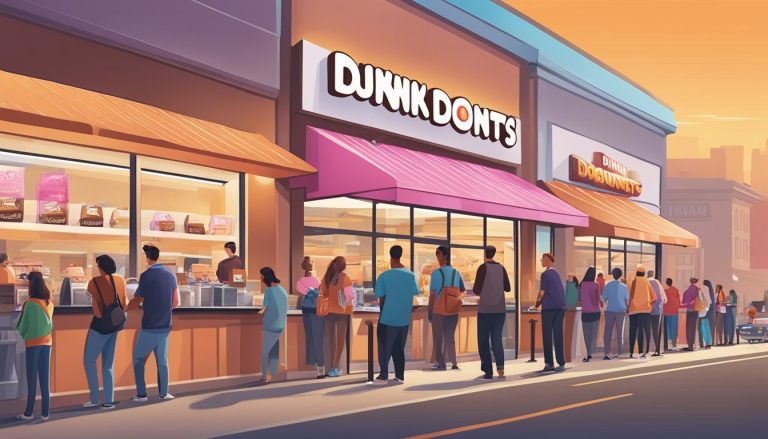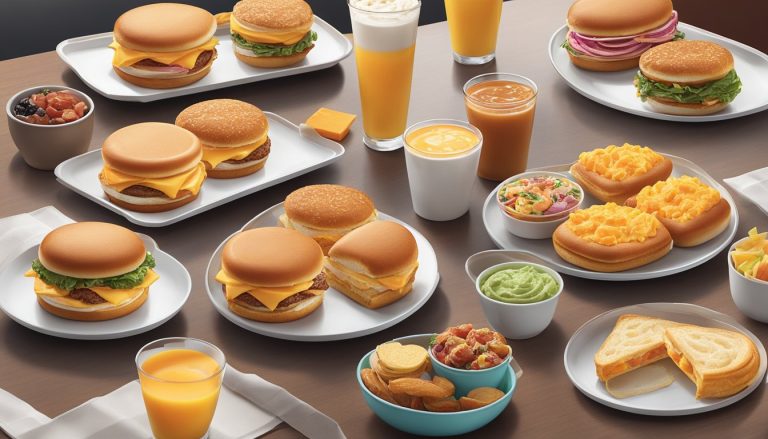Dunkin’ has become a staple in American breakfast culture since its founding in 1950. The chain’s evolution from a donut shop to a coffee and breakfast powerhouse reflects changing consumer preferences and has significantly shaped morning routines across the nation. Dunkin’ now serves over 3 million customers daily, with its menu offerings playing a crucial role in defining what many Americans consider a typical breakfast.
The quick service industry has seen fierce competition in the breakfast segment, with Dunkin’ at the forefront of innovation. By expanding beyond traditional donuts and coffee to include breakfast sandwiches, wraps, and even breakfast tacos, Dunkin’ has adapted to meet diverse consumer needs. This expansion has influenced other chains to broaden their breakfast menus, creating a ripple effect throughout the industry.
Dunkin’s impact extends beyond just food choices. The company’s emphasis on convenience and speed has set new standards for how Americans approach their morning meals. With drive-thru options and mobile ordering, Dunkin’ has catered to the fast-paced lifestyle of modern consumers, reinforcing the notion that breakfast can be both quick and satisfying.
Historical Evolution of Dunkin’
Dunkin’ has undergone significant transformations since its inception, shaping American breakfast habits along the way. The company’s journey from a local donut shop to a global brand reflects changing consumer preferences and market trends.
From Dunkin’ Donuts to Dunkin’
Dunkin’ Donuts began in 1950 when William Rosenberg opened his first shop in Quincy, Massachusetts. The brand quickly gained popularity for its coffee and donuts. As tastes evolved, Dunkin’ expanded its menu to include breakfast sandwiches, bagels, and other offerings.
In September 2018, the company announced a major rebranding initiative. The iconic “Dunkin’ Donuts” name was shortened to simply “Dunkin'”. This change reflected the brand’s broader focus beyond donuts, emphasizing its coffee and other beverage options.
The rebrand also aimed to create a more modern image and appeal to health-conscious consumers. Dunkin’ introduced healthier menu items and focused on its coffee offerings to compete in the changing marketplace.
The Legacy of William Rosenberg
William Rosenberg’s vision laid the foundation for Dunkin’s success. He pioneered the concept of a quick-service restaurant focused on coffee and donuts. Rosenberg’s innovative approach helped create the now-familiar habit of stopping for coffee and breakfast on the way to work.
His emphasis on franchising allowed Dunkin’ to expand rapidly. Rosenberg’s business model became a template for many fast-food chains that followed. His legacy continues to influence Dunkin’s operations and growth strategies today.
Rosenberg’s creation has grown from a single shop to a global brand serving millions daily. His vision of providing quality food and beverages quickly and affordably remains central to Dunkin’s mission.
Dunkin’s Expansion and Market Influence

Dunkin’ has grown from a single shop to a global powerhouse through strategic franchising and fierce competition with other coffee giants. Its expansion has reshaped American breakfast habits and the coffee market landscape.
Franchising Strategies
Dunkin’ embraced franchising early on, fueling rapid growth across the United States. The company offers turnkey operations, comprehensive training, and marketing support to franchisees. This model allows for local ownership while maintaining brand consistency.
Dunkin’ carefully selects franchise locations based on demographics and traffic patterns. The brand targets high-visibility areas like shopping centers and busy intersections. Multi-unit franchising deals have accelerated expansion in recent years.
Internationally, Dunkin’ adapts its menu and store designs to suit local tastes. This flexibility has enabled successful entry into over 35 countries. The franchise system continues to drive Dunkin’s global reach and market influence.
Competition with Starbucks and Krispy Kreme
Dunkin’ competes directly with Starbucks in the coffee shop market. While Starbucks focuses on premium offerings, Dunkin’ positions itself as a more affordable option. This strategy has helped Dunkin’ capture budget-conscious consumers and expand its customer base.
Dunkin’ has invested heavily in improving coffee quality to challenge Starbucks’ dominance. The brand now offers a wide range of coffee varieties, including cold brews and espresso drinks. These efforts have strengthened Dunkin’s position in the competitive coffee market.
Against Krispy Kreme, Dunkin’ emphasizes its broader menu and convenience. Dunkin’ stores often feature drive-thrus and mobile ordering options. This focus on speed and variety gives Dunkin’ an edge in capturing busy breakfast customers.
Dunkin’s Impact on Breakfast Consumption

Dunkin’ has significantly shaped American breakfast habits through menu innovations and a focus on convenience. The company’s strategies have influenced how and what people eat in the morning.
Breakfast Menu Innovations
Dunkin’ regularly introduces new breakfast items to stay competitive. The Dunkin’ Breakfast Taco represents a recent attempt to capture market share. This product appeals particularly to younger consumers, with 26% of rural residents showing interest.
Dunkin’ also competes in the “Breakfast Wars” by expanding its sandwich offerings. The chain has adapted its menu to cater to local preferences across different regions. This approach ensures a tailored experience for customers and helps maintain Dunkin’s relevance in various markets.
Convenience as a Driver of Consumption
Dunkin’s widespread presence and quick service model have made it a go-to option for busy Americans. The company’s slogan, “America runs on Dunkin’,” reflects its role in many people’s morning routines.
Drive-through options and mobile ordering further enhance convenience. These features allow customers to grab breakfast on-the-go, fitting into fast-paced lifestyles. As a result, 49% of American adults report being at least “somewhat likely” to order breakfast from fast-food chains like Dunkin’.
The ease of access to Dunkin’ locations has influenced breakfast consumption patterns. Many consumers now rely on quick, ready-made options rather than preparing meals at home.
Dunkin’s Product and Service Offerings

Dunkin’ has expanded its menu far beyond its original donut offerings. The company now provides a wide range of beverages and food items to cater to diverse customer preferences throughout the day.
Coffee and Espresso-Based Drinks
Dunkin’ is renowned for its quality coffee, which forms the cornerstone of its beverage lineup. The chain offers hot and iced coffee in various flavors and strengths. Popular choices include:
• Original Blend
• Dark Roast
• Cold Brew
Espresso-based drinks have also gained prominence on Dunkin’s menu. These include:
- Lattes
- Cappuccinos
- Americanos
- Macchiatos
Dunkin’ frequently introduces seasonal flavors and limited-time offerings to keep its beverage menu fresh and exciting.
Beyond Donuts: Expanding Food Options
While donuts remain a signature item, Dunkin’ has significantly broadened its food selection. Breakfast sandwiches have become a major focus, featuring combinations of:
• Eggs
• Cheese
• Meats (bacon, sausage, ham)
• Bread options (croissants, bagels, English muffins)
Other popular food items include:
- Bagels with cream cheese
- Muffins
- Wraps
- Hash browns
Healthier options like oatmeal and fruit cups have also been added to cater to health-conscious consumers.
Adapting to Consumer Trends and Preferences

Dunkin’ has shown remarkable agility in responding to evolving consumer preferences. The company has embraced digital technologies and personalized marketing strategies to enhance customer experiences and drive loyalty.
Mobile Ordering and Digital Engagement
Dunkin’ launched its mobile app in 2012, allowing customers to order and pay ahead. This move significantly reduced wait times and improved convenience. The app’s user-friendly interface lets customers customize orders, find nearby locations, and track rewards.
In 2019, Dunkin’ invested $100 million to modernize its digital platforms. This upgrade included AI-powered recommendations and streamlined order processing. The company also partnered with third-party delivery services to expand its reach.
Dunkin’s mobile strategy has paid off. In 2024, mobile orders accounted for 25% of transactions, up from 12% in 2019.
Loyalty Programs and Personalization
DD Perks, Dunkin’s loyalty program, boasts over 15 million members as of 2025. The program offers points for purchases, free beverages on birthdays, and exclusive deals.
Dunkin’ uses data analytics to tailor promotions to individual preferences. This approach has increased customer retention by 18% since 2020.
The company regularly updates its rewards structure based on consumer insights. In 2023, Dunkin’ introduced tiered rewards, offering higher-value perks to frequent customers.
Dunkin’ also leverages social media for targeted marketing campaigns. Its “Go2s” promotion, which offered discounted breakfast combos, generated significant buzz on platforms like Instagram and TikTok.
Dunkin’s Cultural and Societal Influence

Dunkin’ has become deeply ingrained in American culture, shaping breakfast habits and social interactions across diverse communities. Its widespread presence and marketing strategies have made it a recognizable brand that resonates with both urban and rural consumers.
Addressing Urban and Rural Markets
Dunkin’ has strategically expanded its reach to cater to both city dwellers and rural residents. In urban areas, Dunkin’ locations serve as convenient stops for busy professionals seeking quick breakfast and coffee options. The chain’s drive-thru services and mobile ordering capabilities particularly appeal to time-pressed city customers.
In rural communities, Dunkin’ often becomes a social hub where locals gather for coffee and conversations. The brand’s affordable prices and consistent quality make it accessible to a wide range of consumers, regardless of their location or socioeconomic status.
CivicScience data reveals that Dunkin’ has successfully captured a significant market share in both urban and rural settings, with loyal customer bases in each.
Dunkin’s Rise in Pop Culture
Dunkin’ has solidified its place in American pop culture through clever marketing campaigns and celebrity partnerships. The brand’s catchy slogans, such as “America Runs on Dunkin’,” have become part of everyday vernacular.
Celebrity endorsements have further boosted Dunkin’s cultural relevance. Notably, comedian Pete Davidson’s highly publicized partnership with the brand has resonated with younger audiences, increasing Dunkin’s appeal among millennials and Gen Z consumers.
Dunkin’ has also embraced its reputation as a favorite among night owls, with many locations offering 24-hour service. This has made the brand a go-to option for late-night cravings and early morning fuel, cementing its status as a cultural icon for all hours of the day.
Innovative Beverage Introductions

Dunkin’ has revolutionized its beverage lineup with cold brew, nitro coffee, and enhanced caffeine options. These innovations cater to changing consumer preferences and elevate the coffee experience.
Cold Brew and Nitro Coffee
Dunkin’ introduced cold brew coffee to meet growing demand for smoother, less acidic cold coffee options. The slow steeping process creates a rich, full-bodied flavor. Cold brew quickly became a popular menu item, especially during warmer months.
Building on this success, Dunkin’ launched nitro coffee. This cold brew infused with nitrogen creates a creamy texture and cascading effect when poured. Nitro coffee appeals to customers seeking a premium coffee experience without added sweeteners or creamers.
Both offerings expanded Dunkin’s cold beverage menu significantly. They also positioned the brand as an innovator in the competitive coffee market.
The Caffeine Experience
Dunkin’ has focused on enhancing its caffeine offerings to meet consumer demand for energy boosts. The company introduced espresso-based drinks like lattes and cappuccinos to compete with specialty coffee shops.
Dunkin’ also revamped its espresso machines and trained staff to improve drink quality and consistency. This move aimed to attract customers seeking premium coffee experiences.
The brand expanded its energy drink options as well. Dunkin’ Energy Punch, made with fruit flavors and B vitamins, targets younger consumers looking for alternatives to traditional coffee.
These caffeine-focused innovations have helped Dunkin’ capture a larger share of the beverage market. They also reinforce the brand’s commitment to meeting diverse customer needs.
Analyzing Dunkin’s Business Performance

Dunkin’ Brands Group has maintained a strong position in the quick-service restaurant industry. The company’s focus on coffee and breakfast offerings has driven significant growth over the years.
Franchising plays a crucial role in Dunkin’s business model. With over 11,300 locations worldwide, the franchise system allows for rapid expansion while minimizing capital expenditure.
Dunkin’s restaurant experience emphasizes speed and convenience. The company has invested in digital ordering and mobile payments to streamline customer transactions and reduce wait times.
Consumer insights have shaped Dunkin’s menu evolution. The brand has expanded beyond donuts to offer a wider range of breakfast items and beverages, catering to changing consumer preferences.
Key performance metrics for Dunkin’ include:
- Annual coffee sales: Estimated $1.6 billion
- Daily customer count: Over 3 million
- Product variety: 50+ types of donuts
Promotions have been instrumental in driving customer engagement. Dunkin’ regularly introduces limited-time offerings and seasonal specials to attract new customers and encourage repeat visits.
The company’s competitive landscape includes major players like Starbucks and McDonald’s. Dunkin’ has positioned itself as a more affordable alternative while still offering premium coffee options.
Adapting to market trends, Dunkin’ has invested in healthier menu items and plant-based alternatives to appeal to health-conscious consumers.




